Top 75 Spaceships in movies and TV
With exclusive insight from the creators, here are some of the best means for getting around the galaxy...
I’ve cut this article into as few pages as the internal workings at Den Of Geek allow, and you can see the entire list of choices in the table below.
These are personal choices of favourite spaceships, and the fact that some of the creators behind them have been kind enough to talk to me about them in no way implies that they endorse those choices or the placement of them in the list (at the time of the interviews, I didn’t even know what the final placement was going to be). – Martin Anderson
INDEXClick to go the entry for each spaceship, or just scroll down and start reading…
 |  |  |  |  |
 |  |  |  |  |
 |  |  |  |  |
 |  |  |  |  |
 |  |  |  |  |
 |  |  |  |  |
 |  |  |  |  |
 |  |  |  |  |
 |  |  |  | |
 |  |  |  |  |
 |  |  |  |  |
 |  |  |  |  |
 |  |  |  |  |
 |  |  |  |  |
 |  |  |  |  |
75: Friede – Frau im Mond (aka Woman In The Moon, By Rocket to the Moon, 1929) | RETURN TO INDEX
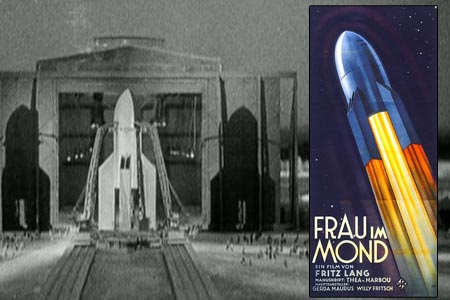
Not only is the rocket in Fritz Lang’s precocious space outing a beautiful example of Art Deco sci-fi before the bulbous curves of Flash Gordon took over, but it’s also an amazing foreshadowing of the ‘staged’ separation that would ultimately take man into space (you can see a video clip of that sequence here). Even thirty years later, Hollywood was still stuck on the ‘single stage’ ship when depicting space travel.
The film was very popular with Wernher von Braun and his associates, who would ultimately take America to the moon with very similar methods (even if they wisely chose not to launch the Apollo missions from under the sea, as with the Friede). The first successful V2 launch from the rocket research facility at Verein für Raumschiffahrt bore the logo of the Friede from Woman In The Moon. Consulting rocket scientist Hermann Oberth had originally intended to build an actual working rocket miniature for Lang, but was constrained by budget and schedule. Happily the Friede has actually flown since, several times.
Info: Fictional Life | IMDB | Mateen Greenway recreation |
74: BTA fighter – Enemy Mine (1985) | RETURN TO INDEX
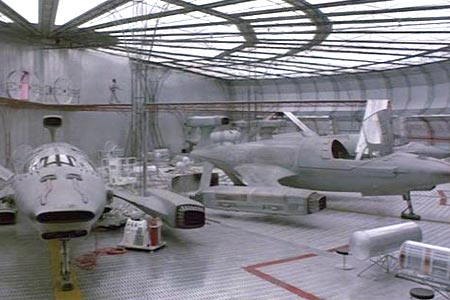
Wolfgang Peterson’s unofficial sci-fi remake of Hell in the Pacific (though actually based on the Hugo-winning novella of the same name by Barry B. Longyear) is a low-tech outing topped and tailed by some pretty cool sci-fi vehicles and environments. The BTA fighter that Dennis Quaid crashes onto Fyrine IV has some rather aquatic styling, and seems apt for a Roger Moore 007 entry. Six differently-sized versions of the craft were made by Joachim Weber & Patric Wollensack for ILM, with the 6-foot ‘hero’ model shown above getting a final paint-job. A number of model kits of the BTA fighter are available, and it’s also a popular design for hobbyist CGI modellers. By the way, anyone who wants to take a walk around Enemy Mine‘s Alliance space-station set can do so for the cost of a ticket to Germany – Bavaria Film Studios retain the set as a tourist attraction!
Info: Fictional Life | IMDB
73: Dr. Zarkov rocket ship – Flash Gordon (1936) | RETURN TO INDEX
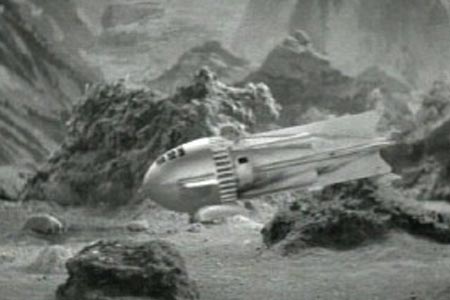
In the absence of more detailed information I can only credit Ralph Berger, art director on the hugely popular RKO cine-serial Flash Gordon (1936), with the delightfully wacky art-deco stylings of Dr. Hans Zarkov’s ship. It’s basically a bullet-shaped, drag-resistant projectile with four spoilers and two aft stabilising fins, all apparently powered by some 50p sparklers. But if you like art deco (which I do), this is bound to be a favourite. The original ship in Alex Raymond’s 1934 strip was a little more sober, perhaps to distinguish it from the outlandish, fin-bestrewn styling of Mongo’s various kingdoms. Director Mike Nichols took the same approach in his cult 1980 remake of the serial, where ex-NASA scientist Zarkov’s vessel is rather more toned-down than its 1930s forebear.
There doesn’t seem to be a huge amount available in terms of replicas and kits. There’s a nice resin model from Herb Deeks; a desk-model occasionally available on eBay; and for CGI buffs, a mesh for Google Sketchup. If you’re curious about the original space-adventurer, you can watch (or download) Flash Gordon Conquers the Universe (1941) quite legally via the Internet Archive.
Info: Fictional Life | IMDB |
72: The Hunter-Gratzner – Pitch Black (2000) | RETURN TO INDEX
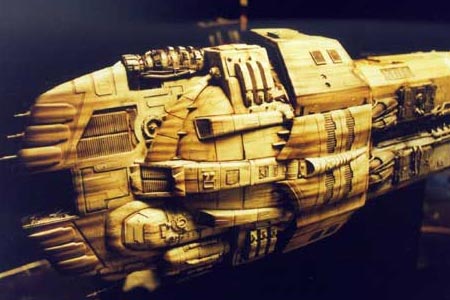
The opening of David Twohy’s tense sci-fi thriller, where marooned astronauts find themselves fighting a very nasty indigenous breed on a hostile planet, begins with a truly exciting crash sequence that’s really nailed home by the lack of score. The cargo spacecraft Hunter-Gratzner makes performs a dazzling reversal of Apollo-era dynamics, shedding entire sections of its fuselage and propulsion systems in order to become light enough to survive a headlong crash through the planet’s atmosphere. The side-panelling is torn off as the doomed ship cruises at terrifying speed over the planet’s surface, ready to meet an even worse fate.
The ship itself is in the long-and-narrow class arguably invented (for the movies at least) with the Discovery in 2001: A Space Odyssey, with substantial boosters at the back, navigation module in the vanguard and a series of modular and very commercial-looking cargo sections, which ultimately threaten to become ballast during the chaotic descent, even though there are people in them…
The model itself was designed by Matthew Gratzner and built by himself and working partner Ian Hunter for Hunter/Gratzner Industries Inc (now New Deal Studios. The nine-foot miniature weighed approximately 270 pounds, with a steel structure and largely custom-moulded detailing. The internal steel spine was modular, to allow for the separation of sections required in the script.
For the atmospheric entry, UV paint was applied to sections of the model to provide animators with a hook for the atmospheric drag on the craft. To simulate violent turbulence in one particular shot, the photographing DP was shaken by two technicians with live power tools! The main miniature was created at 1/36th scale, with larger-scale sections for particular shots, such as the deployment of the air-brakes.
Check out the link directly below for much more background on the Hunter-Gratzner, in our lengthy chat about the model with model-maker Ian Hunter himself. In the full-length interview, you can also find out why the ship was named after its real-life creators at the last moment!
EXCLUSIVE:Ian Hunter, miniature effects supervisor at Hunter/Gratzner Industries Inc (now New Deal Studios) talks exclusively to us about the design and execution of the ship –
“…The spaceship itself needed to change into something that could be taken apart into pieces, so that you could start at the back and work your way forward to get to the point where she could be potentially jettisoning the cargo, which was human beings. From then the ship changed somewhat in shape and we came up with this concept of sort of a space-tug that carried containers.
“…Matthew [Gratzner] actually did the final design. But we followed the same trend, which was a long ship with an engine in the back, a control-section in the front and then containers along the way. The thought was that the containers could be jettisoned and that the engine could be jettisoned and incrementally cut off the ship, leading to just the ‘survival’ section, which is the control pod at the front.
“We were reading at the time about this space-plane, which uses internal-combustion wedged-shaped engines, so we came up with these engine shapes that were more reminiscent of what the space-plane was supposed to have. So this was lifting and stealing from real technology and trying to stick it on to something that felt very utilitarian. Like you said, it’s got scrape marks on it, and the containers themselves are painted different colours so they look like they’re from different manufacturers and different brands that have been strung together to be run through space.
“For us, creatively, it was one of the more satisfying jobs, because it was something we were really invested in; we were not being handed drawings or handed sketches from somebody, but actually investing our time into it…”
Click here for the full-length exclusive interview with Ian Hunter
As this page at a Rhianna Griffiths fan-site proves, you can go and enjoy what’s left of the on-set version of the Hunter-Gratzner, as the remnant prop now a tourist attraction out in the Arizona location. For tons of background on the movie, visit the ultimate Pitch Black fan site here. As for replicas and toys, how about the ship in Lego? As for the original model, it still sits proudly in the offices of New Deal…
Info: Fictional Life | IMDB |
71: Saucer – The Thing (1982) | RETURN TO INDEX
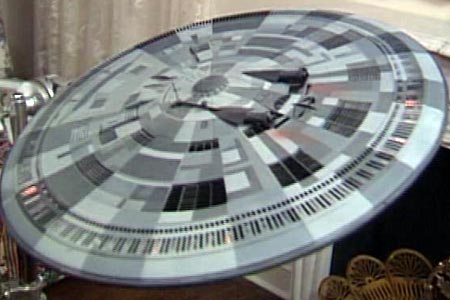
I’ve had to be careful about including too many ‘saucer ships’ in this list. It’s an awfully basic design that needs a wrinkle or two to stand out from a rather crowded field of spaceship-design. But modelmaker Susan Turner produced a quite extraordinary miniature (from blueprints by production designer John Lloyd) for John Carpenter’s classic chiller, and one that deserved more than the two shots it got at the start of the film (the other views of the ‘excavated’ saucer were combinations of minimal props and matte painting by Albert Whitlock).
The saucer is made of ABS plastic to resist the 144 grain-of-wheat lights shuttered inside the chassis (to prevent ‘hotspots’). The circulating light pattern is variable both in speed and intensity so as to give John Dykstra’s Apogee FX house free reign to shoot at any FPS needed. The saucer is trimmed in etched brass for detail and the top dome rendered in hammered brass with an internal light. There’s no ‘blind side’ to the model, as it pitches and yaws enough to display all its aspects in the opening shot of the descent towards the Earth’s atmosphere. Panel detail was applied with masking and airbrush, and the final model was shot in 4 passes – one for detail, 2 for light and one for a silhouette matte against which to drop in the stars behind. There are ‘hero’ ships in regular TV shows that don’t have this kind of flexibility or painstaking detail.
The model itself remains with Susan Turner, though the John Lloyd blueprints were obtained by one fervent collector from visual effects masters Dennis and Robert Skotak (who lost the bid to design the ship), and you can check them out here. In the meantime, true Thing fans aren’t being put off, and one even created a beautifully detailed diorama of the spaceship stuck in the ice, complete with McReady and company looking on from the ridge!
Info: Fictional Life | IMDB |
70: Patrol Ship – Saturn 3 (1980)| RETURN TO INDEX
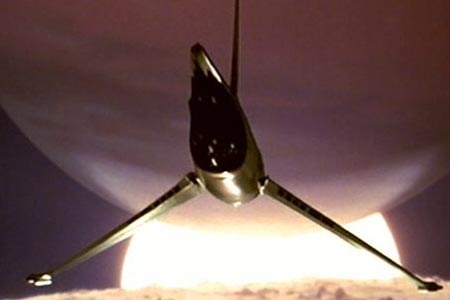
The patrol that checks up on shadowlocked Tethys towards the climax of Stanley Donen’s disastrously unsuccessful space-thriller is as derivative of the colonial vipers in 70s Galactica and the Orion in 2001: A Space Odyssey (both featured later in the list) as the film itself is of Alien. Yet the Orion drew on NASA’s tentative space-shuttle plans just as the vipers drew (heavily!) on Star Wars’ X-Wing (and went on, it seems, to inform the look of the snow-speeders in The Empire Strikes Back). So let’s not be throwing stones. This is an extraordinarily elegant-looking ship, combining the long lines of an ocean clipper with the sensibility of the jet-age. Visual effects supervisor Colin Chilvers had variable results in a punishing stint on the movie, but pulled together this design and execution very nicely. Oddly enough, this vessel deserves the name ‘Y-wing’ far more than the one in Star Wars. Toys? Models? The producers wished anyone had been that interested. Info: Fictional Life | IMDB |
69: Uncle Martin’s Spaceship – My Favorite Martian (US TV, 1963-65)| RETURN TO INDEX
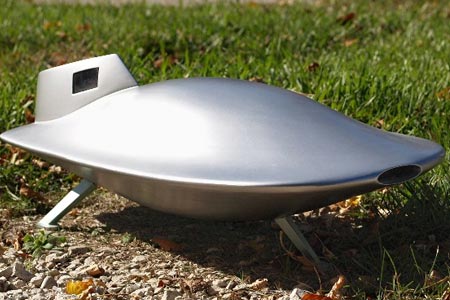
Based on the design of an e-type Jaguar, this unnamed vessel had to be small enough to fit in a garage but still convince as alien technology. The solution is sleek, shimmery and rather sexier than the show it was in; if 007 had to go into space again (I’m really not recommending that he does), this is the kind of style that’s requisite, and it wouldn’t look bad underwater either. Art Director James Hulsey retained the e-type’s characteristic vent, and later remodelled the unsophisticated hatch-release mechanism into an elegant split of windowed gull-doors. The prop was originally made as silver-painted wood, but later recast in fibre-glass with a steel framework. In the shooting of a later episode, part of the steel structure snapped away and almost killed the actor inside. MFM expert J.H. Harrison notes that though the design incorporates three exits for landing legs, they are never actually depicted in the show (something we’ll be coming across later with the Narcissus from Alien). The full-size prop was sold at a car auction in LA in 1985 and several times thereafter. It was last known to be in the possession of a memorabilia collector in the early nineties.
Modeller Brent Gair made a 25″ replica of the spaceship, and there was even a very basic commercial kit on the market in the 1960s (click here to see how basic).
Info: Fictional Life | IMDB |
68: Garbage Scow – Quark (US TV , 1978)| RETURN TO INDEX
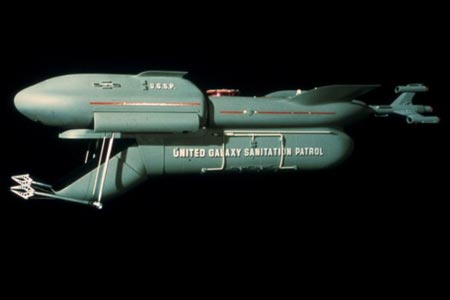
I’ve got a bit of a soft spot for this very bizarre-looking and Roddenberry-esque interstellar garbage truck. What most people seem to remember of Quark are the Barnstable twins; perhaps that’s not unreasonable – the show was cancelled for a reason! But I can’t help liking the rather muted sixties pastel green and unintuitive arrangement of shapes on the United Galaxies Sanitation Patrol Cruiser. The Roddenberry connection is no surprise, since the show did direct parodies of several specific Star Trek episodes.
Info: Fictional Life | IMDB |
67: Whale probe – Star Trek IV: The Voyage Home (1986) | RETURN TO INDEX
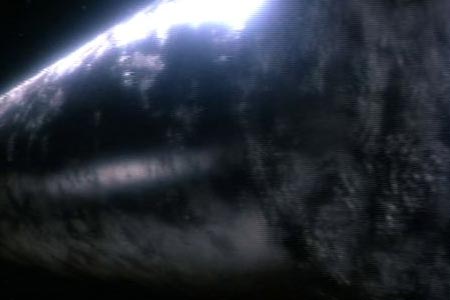
On the surface, this shouldn’t be in anyone’s list of top spaceships, because it’s basically just a pitted metal cylinder. But the elegance kicks in when the probe opens up and reveals the glowing suspended transmitter which wreaks havoc with the Earth’s atmosphere whilst trying to communicate with the now-extinct whales. At the end of the movie we’re provided with one of the most beautiful and inspiring VFX sights since 2001: A Space Odyssey, as the whales our heroes have brought back to the 23rd century line themselves up, heads-down, for a chat with the probe – which assumes the same position, revealing a kinship with the whales.
On a recent ‘special edition’ DVD of Voyage Home, model-shop supervisor Jeff Mann explains the difficulty the probe posed for Industrial Light And Magic:
“There was some difficulty early on with the probe. Trying to get that to have some scale was difficult. It was big and shiny and it had blue-spill problems. We did some tests early on as to texture, and what we had to do to give it the kind of scale that the Star Wars ships have.”
Mann goes on to reveal that three different probes were built: a small one for long shots, approximately two feet in length; an intermediary and a hero version. “We took a piece of irrigation pipe. It was probably two and a half feet in diameter.” The assembly was mounted on a motion rig at ILM, and also allowed for a certain amount of rotation of the miniature. visual effects supervisor Ken Ralston had the model repainted black after initial test shots were made, which added to the logistics of providing effective scale for the probe.”
Not surprisingly, the design of the whale probe has proved too paltry a challenge for CGI enthusiasts, and too simple a shape for toy and model manufacturers, but you can buy the probe as an add-on in Second Life, complete with hauntingly authentic sound effects.
Info: Fictional Life | IMDB |
66: Icarus II – Sunshine (2007)| RETURN TO INDEX
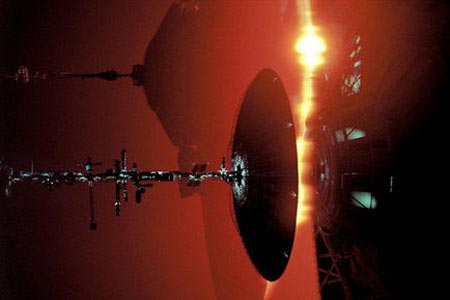
The central spaceship of Danny Boyle’s SF chiller redefines the concept of ‘unbalanced’ in spacecraft design, as the vast majority of its bulk is taken up with a vanguard of enormous, almost continental heat-shield, in order to protect the craft from the murderous rays of the dying sun that its crew is hoping to revive. The design’s sheer commitment to space – this ship ain’t landing anywhere, ever – makes the Icarus II a unique design amongst screen space-vessels, and the finishing and detail are quite exquisite. It’s only a shame that the early commitment to rotating gravitised sections was abandoned early on in the conceptual process (see entries here on 2010 and Mission To Mars for rather more committed concepts).
At this site a little background information emerges on production designer Mark Tildesley’s brief for the Icarus:
“Mark is a genuine creative person and, like me, loves photography books which was a great language for us to work through,” Boyle explained in one interview, later revealing that the Icarus II was to convey “the sense of it being an organic, living thing that could break down and would need to be fixed”.
Tildesley himself commented: “We wanted to make the ship very real and believable for the audience so they would buy into the mission.”
And if this rather engaging SF film hadn’t suddenly turned into a confusing horror-slasher half-way through, that would have been an easy sale.
Info: Fictional Life | IMDB |
65: The TARDIS – Doctor Who (UK TV, 1963-???)| RETURN TO INDEX
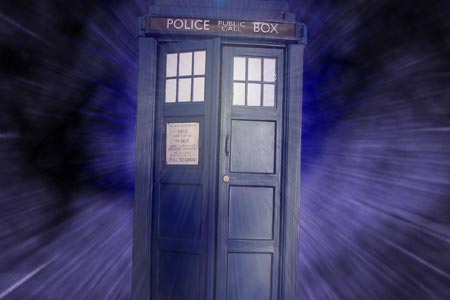
It’s got more angles than a card shark, it’s in a shocking state and I’m not 100% sure that it’s even a spaceship – but it’s certainly made an impact on the culture. Metropolitan Police surveyor Gilbert Mackenzie Trench designed the classic police box in 1929 after visiting Birmingham and approving of an early police-box scheme running in that city (you can find out more about the pre-Who history of the box here). But it was BBC staff writer Anthony Coburn who added the innovation of a chameleon time-machine to C. E. Webber’s script for An Unearthly Child, the first adventure of the Doctor in 1963. We know that it’s a time machine, but quite how the TARDIS moves through space has been differently interpreted over the 30 seasons of the show’s (often interrupted) run. Early episodes simply depicted the box dematerialising in one place and materialising in another, which placed minimum strain on a limited special-effects budget and suggested a space-folding capacity similar to that of the guild navigators in Dune. Later episodes didn’t shy away from showing the TARDIS as an actual space-vehicle, irrespective of its capacity to travel through time, and in David Tennant’s reign, the TARDIS has even taken part in a motorway chase!
The TARDIS interior has been refitted many times, but designer Richard Hudolin (Battlestar Galactica/Caprica) created the most radical ‘steampunk’ vision of the interior for the 1996 Doctor Who movie with Paul McGann – the Verne-esque stylings are delightfully retro and were to become a big influence on new Who…
EXCLUSIVE:Caprica/Galactica production designer Richard Hudolin talks exclusively to us about his 1996 vision for the TARDIS:
“I didn’t know anything about the show when they called me. It was retro-tech but it involved all kinds of different…it was like taking Jules Verne and putting your own stamp on it. The [TARDIS interior] was just a whole collection of different architectural styles. I’d ask myself how the Doctor would do it, and I’d have a ballroom with a piano, or over there a library with those big rolling ladders, and over there like a Roman archway or a gateway to somewhere else…so again it was one of those situations where there was something that already existed and the people that I was working with said ‘We don’t want to go back to that – we want to get far away from that; what do you think you can do?’. And so I started coming up with these concepts and they just all loved them. The further I went, the more they liked it!”
Click here for the exclusive full-length interview.
The ‘chameleon circuit’ that disguises the Doctor’s means of transport didn’t get the original London police-box entirely right; in the version on which the TARDIS is based, the doors open out, not in. You can find out much more about the history of the on-set ‘practical’ TARDIS here. And some full-size fibre-class reconstructions here.
Why is this not higher in the list? Much as I love Doctor Who and the TARDIS, it’s not really much of a looker, is it?
Info: Fictional Life | IMDB |
64: Fireball XL5 – Fireball XL5 (UK TV, 1963) | RETURN TO INDEX
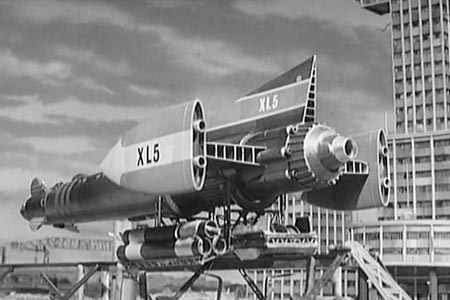
Gerry Anderson’s first committed sci-fi TV series boasted a spaceship full of wonderful lines, shapes and invention. The separation of ‘Fireball Junior’ from the main craft was an elegant idea destined to be delightfully re-implemented for the Skydiver sub/air vessel in Anderson’s UFO TV series in 1969-70; but the luscious lines of XL5 are pure Dan Dare (and about as near as any of us will ever get to a recreation of that Brit comic classic, since Blightey didn’t have the money to do anything with Martin Bower’s superb models for the proposed TV show/film in the 1980s). Legendary visual effects wizard Derek Meddings, later to work on The Empire Strikes Back as well as most of the 007 outings of the 1970s, used some surprisingly ‘BBC’ techniques’ to generate the shape of the craft, which was drawn from household liquids bottles stuck together, painted and decorated with ‘nurnies’ (parts sequestered from model kits) and ‘dirtied down’ to give the impression of usage.
In terms of marketing, Gerry Anderson remains George Lucas’s direct predecessor, and this is a widely diffused design both in the toy and model marketplace and in the sphere of 3D hobbyists. Though XL5 is no longer available with a three-stage lolly, you can get it die-cast and as a hard-vinyl candy toy. There are some excellent CGI recreations/imagining of XL5 scenarios at this site, an unusual paper-model recreation here, and you can even fly Fireball XL5 in Microsoft Flight Simulator 98. What’s harder to find is a model-kit; Airfix produced an injection-moulded kit as a promotional item in 1964, obtainable only as a mail-away gift for a brand of ice-cream, and this model was later used as the basis for a now-discontinued resin and white-metal replica from Comet miniatures- who subsequently output a metal kit of the XL5 and a resin kit of the charming ‘Fireball Junior’ head-section. There’s advice at tvcentury21.com about how to use the same model-kits that Meddings did when dressing the original, to faithfully recreate your own XL5, along with a list of the key kits involved. CGI enthusiasts looking for a shortcut or unimpressed with open-source versions can buy a mesh of the ship at Turbosquid.
EXCLUSIVE:Gerry Anderson talks exclusively with us on the design on Fireball XL5:
“Having the head separate from the main body was a very simple decision to make; I always tried, with all my shows, to make them as believable as possible, and having seen the way that Fireball XL5 was launched…if one took one’s imagination now to a planet where they were going to land, how were they going to find a piece of flat ground where a rocket that weighs God-knows-what could land safely without sinking into the sand, or mud or whatever? So that was the key to having a ‘Fireball 2’ that could land and leave the mothership in orbit. It was all based on, common sense and the knowledge we had at the time.”
Gerry Anderson has more to say on XL5 in our exclusive interview
Info: Fictional Life
| The Models Of Fireball XL5 | IMDB | Amazon|
63: The Lewis & Clark – Event Horizon (1997) | RETURN TO INDEX
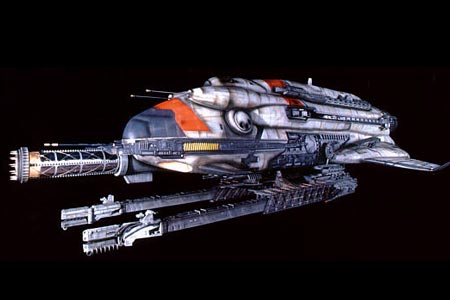
Whatever your opinion on Paul W. Anderson’s ‘ghost story in space’, it can’t be denied that there are some fantastic space vessels on display, courtesy of production designer Joseph Bennett (who we spoke to about it, see below). We’ll get onto the Event Horizon ship itself a little later, but the relative pygmy-vessel Lewis & Clark has some very nice lines of its own, and it’s just a shame that we never really get a great look at it in the movie itself. Vehicles like the Nostromo tug use jutting struts off-set for a casual air, but the Lewis & Clark is standing very much to attention, focused forward. Are these promontories weapons or sensors. For a ‘NASA’-style vehicle, it looks armed to the teeth! It’s still clearly unsuitable for heavy atmospheres, but (as Bennett explains) is capable of landing in light atmospheres. The venerable Richard Yuricich shot the miniatures for Mass Illusions at Pinewood, England .
EXCLUSIVE: Joseph Bennett, ‘Lewis & Clark’ designer
“We wanted to create two very different aesthetics [between the Lewis & Clark and the Event Horizon]. The Lewis And Clark was the type of NASA-aesthetic that you know…a working spacecraft that goes from place to place like an oil-rig helicopter. It’s got the classic space shuttle-based design, very workaday. That was enjoyable doing, because you had to make an environment that works for that. “We did have a scene which eventually got cut from the script due to money and time and the need to keep the movie to ninety minutes. It was a rescue sequence set on an oil-drilling asteroid. They had to go and rescue a guy that was trapped there. It was really nice, but in the end it was something like a twenty-minute sequence, and the need was felt to get into the meat of the film. “We had to do Event Horizon quite quickly. Paul Anderson is a brilliant director and we all just went for it, really. “
Full-length interview with Joseph Bennett coming soon!
Though I’ve not been able to find any model-kit presence for the Lewis & Clark, you can still board the ship itself in the Doom 3 mod, and gamer fans of the movie could do a lot worse than check out Dead Space. More CGI enthusiasts have concentrated on the Event Horizon itself than this smaller ship, possibly due to the difficulty in finding reference images or schematics. If you have a Lewis & Clark mesh, get in touch and I’ll include it here. In the meantime, there was a games miniature produced, which is listed here (direct photo of it here).
Info: Fictional Life | IMDB |
62: Space-junk trawler – UFO (UK TV, 1970)| RETURN TO INDEX
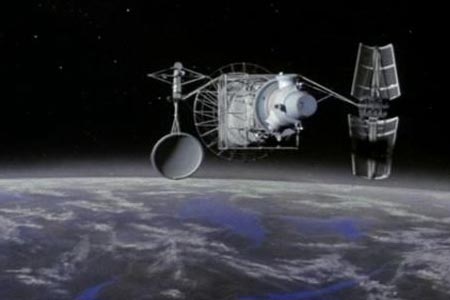
Should I apologise for including a spaceship here that may have slipped the minds even of UFO fans? No way. For anyone who loves the NASA aesthetic, this is a pin-up ship. There’s pretty much no hope of ever finding out who designed it, since it seems to have been cobbled together from spare parts in Derek Meddings’ workshop. The function of this ship, which has the pre-titles sequence of the episode Conflict to itself, is to locate and destroy old and unused space-debris that may interfere with Earth space missions. The sheer imbalance of the craft is delightful, with a solar panel array on one side and some kind of communications dish on the other. It looks like it was built in orbit from the smallest possible requisite number of parts, and it’s just as cool as hell.
No kits, no models. A shame, as it would be a good source for kit-bashing by itself!
Info: Fictional Life | IMDB |
61: Planet Express – Futurama (US TV, 1999-2003+) | RETURN TO INDEX
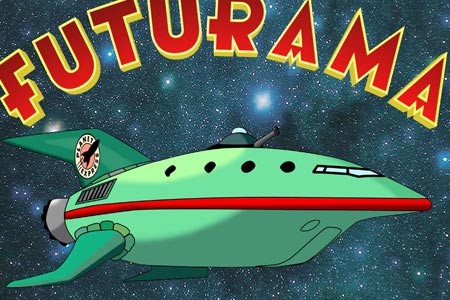
Though series creator Matt Groening consulted with esteemed futurist Syd Mead on the design of our hapless heroes’ spacecraft, it’s not one that the artist included when chatting with us about his spaceship designs for this article. Anyone who remembers the sheer quality of tin ‘space-age’ toys can’t fail to be beguiled by the gorgeous curves of this vehicle. Even the tonality of the greens is pure late-50s, early-60s. The Planet Express was just made for kids to ‘whoosh’ around the room! It’s been noted that, like a great many of Groening’s best-loved characters, the Express has a pronounced overbite, and this is just one of the little features that provides a sexy spin on a classic design motif in spaceships.
There’s a beautiful Skyhook models kit available of the ship, and Moore Collectibles also have a lovely replica to offer. In the hobbyist world there’s a nice Lego version, a purchasable CGI model, another in Max, and Mr. Ronsfield, a German CGI enthusiast, has also paid tribute to the craft.
Info: Fictional Life | IMDB |
CLICK HERE FOR PART 2 OF THE LIST…

